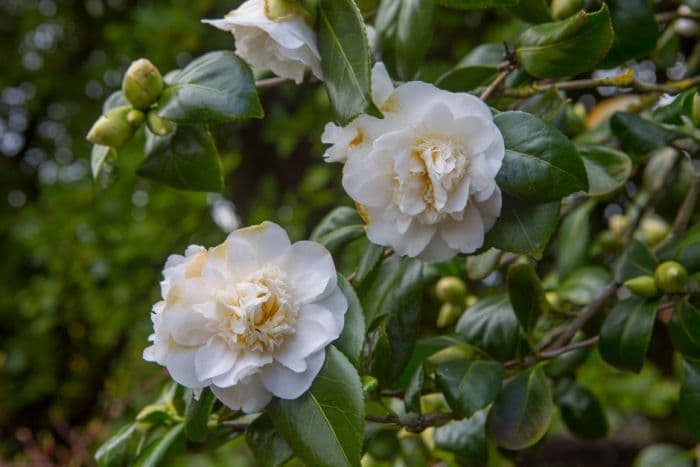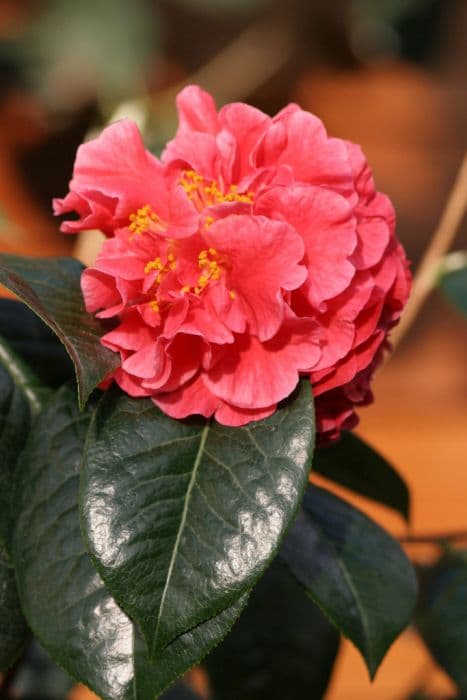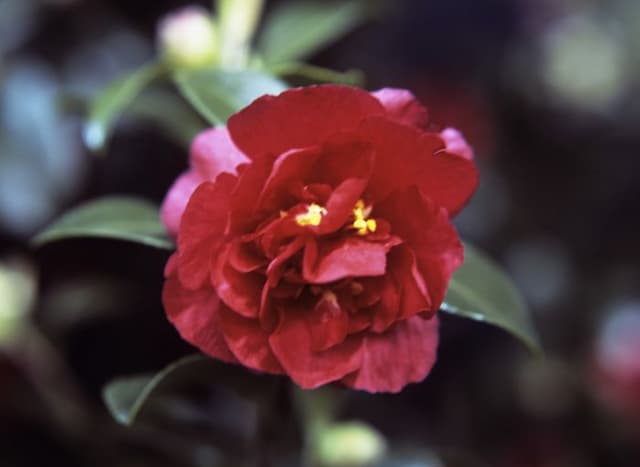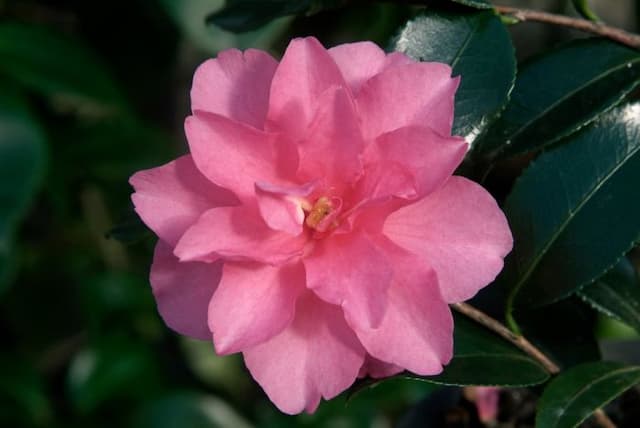Japanese camellia Camellia japonica 'Gus Menard'

ABOUT
The Camellia japonica 'Gus Menard' is an ornamental plant that features an exquisite display of flowers and a lush foliage. The blooms are particularly captivating, with their large peony-like form that showcases swirling layers of petals. These petals are a rich shade of pink, a hue soft yet vibrant enough to draw the eye. As the flowers mature, they open up to reveal a cluster of bright yellow stamens at their core, creating a beautiful contrast with the pink petals. The leaves of the 'Gus Menard' have a glossy dark green color that provides a perfect backdrop to the showy blossoms. They are leathery to the touch, with a smooth texture and a slightly serrated edge. The plant presents as well-structured, with a symmetrical growth pattern that adds to its ornamental appeal. This Camellia blooms during the colder months, a time when most other plants do not flower, making it a valuable addition to any garden for winter interest. It is not only cherished for the beauty of its flowers but also for the evergreen foliage that maintains its vibrant color throughout the year, adding a consistent splash of greenery to its surroundings. Overall, 'Gus Menard' is a striking plant, both for the charismatic blooms it produces and the dense, glossy foliage that persists regardless of the season.
About this plant
 Names
NamesFamily
Theaceae
Synonyms
Japanese Camellia, Rose of Winter, Common Camellia
Common names
Camellia japonica 'Gus Menard'.
 Toxicity
ToxicityTo humans
The common name for Camellia japonica 'Gus Menard' is Japanese camellia. Japanese camellia is not considered toxic to humans. There are no well-documented cases of poisoning from ingesting this plant, and it is generally regarded as safe. Consequently, there are no specific symptoms of poisoning associated with the Japanese camellia for humans.
To pets
The common name for Camellia japonica 'Gus Menard' is Japanese camellia. Japanese camellia is generally considered non-toxic to pets, including cats and dogs. It is not known to cause poisoning in pets, so there are no specific symptoms associated with ingestion of this plant. Therefore, it is unlikely to cause any adverse effects if consumed by pets.
 Characteristics
CharacteristicsLife cycle
Perennials
Foliage type
Evergreen
Color of leaves
Green
Flower color
Pink
Height
6-10 feet (1.8-3.0 meters)
Spread
6-10 feet (1.8-3.0 meters)
Plant type
Shrub
Hardiness zones
7
Native area
Japan
Benefits
 General Benefits
General Benefits- Aesthetic Appeal: Camellia japonica 'Gus Menard', commonly known as the Japanese camellia, adds visual interest to gardens with its large, ornate flowers that bloom in shades of pink, red, or white during late winter to spring.
- Landscape Versatility: This evergreen shrub can be used in various landscape designs, including formal gardens, woodland settings, and as a specimen or container plant.
- Privacy Screening: With its dense foliage, Japanese camellia can act as an effective privacy screen or hedge, providing seclusion for outdoor living areas.
- Shade Tolerance: Japanese camellias can thrive in partial shade, making them suitable for understory plantings or north-facing gardens where other flowering plants might struggle.
- Low Maintenance: Once established, Camellia japonica 'Gus Menard' requires relatively little care, with minimal pruning needed to maintain its shape and encourage blooming.
- Longevity: Camellias are known for their long lifespan, offering many years of enjoyment from a single planting.
- Wildlife Attraction: The flowers provide nectar for pollinators such as bees, while the dense foliage can offer shelter for birds.
 Medical Properties
Medical PropertiesThis plant is not used for medical purposes.
 Air-purifying Qualities
Air-purifying QualitiesThis plant is not specifically known for air purifying qualities.
 Other Uses
Other UsesCulinary Garnish: Camellia petals can be used to add color and ornamentation to salads and desserts, highlighting the delicate texture and vibrant hues of the flower.
Textile Dye: The Camellia flower can be used in the process of natural dyeing, providing fabric with shades of pink, red, or yellow, depending on the mordant used.
Photography Subject: Garden photographers may use Camellia japonica 'Gus Menard' as a subject due to its unique color and form, as it provides an attractive focal point in flower photography portfolios.
Art and Illustration: Artists and illustrators could draw inspiration from the Camellia's intricate petals and overall shape for botanical artwork and detailed illustrations.
Eco-friendly Confetti: Dried Camellia petals can serve as an eco-friendly alternative to traditional confetti at celebrations, especially weddings, due to their biodegradability.
Handmade Paper: Pieces of Camellia petals can be included in the process of making handmade paper, giving it a decorative and textured appearance.
Decoration in Cosmetics: The flower can be used for the aesthetic embellishment of cosmetic products like bath bombs and soaps for a luxurious and natural touch.
Traditional Arts: In some cultures, Camellia flowers might be used in traditional ceremonies or crafts as a symbol of love or admiration.
Botanical Jewelry: Real or dried Camellia flowers can be embedded in resin to create unique and elegant pieces of jewelry like pendants and earrings.
Tea Ceremony Decor: Camellias, being related to tea plants, can be used as decor in traditional tea ceremonies for a thematic and authentic ambiance.
Interesting Facts
 Feng Shui
Feng ShuiThe Camellia is not used in Feng Shui practice.
 Zodiac Sign Compitability
Zodiac Sign CompitabilityThe Camellia is not used in astrology practice.
 Plant Symbolism
Plant Symbolism- Admiration: Camellias are often associated with deep admiration for someone's qualities and spirit, reflecting a sense of respect and esteem.
- Love: Commonly given as a gift to express romantic interest, camellias symbolize a declaration of love, especially red camellias like 'Gus Menard'.
- Perfection: With its flawless form and petals, the camellia represents the ideal of perfection, striving for and achieving excellence.
- Longevity: Camellias are evergreen and have a long blooming season, symbolizing enduring and steadfast life or relationships.
- Refinement: As a plant traditionally associated with the upper class in Asian cultures, camellias symbolize refinement and thoughtfulness.
 Water
WaterJapanese Camellia 'Gus Menard' benefits from thorough watering, and the frequency depends on the climate and soil drainage. In general, water to a depth of 4-6 inches once a week during dry periods, which usually equates to about 1-1.5 gallons for a medium-sized shrub. Reduce watering in the fall and winter when the plant is not actively growing. Always allow the top inch of the soil to dry out before watering again to prevent root rot. It's vital to avoid overhead watering to prevent fungal diseases; instead, water directly at the base of the plant.
 Light
LightJapanese Camellia 'Gus Menard' thrives best in partial shade, particularly sheltered from the harsh afternoon sun. An ideal spot is under a canopy of tall trees where it receives dappled sunlight or in a north-facing location that gets bright, indirect light. Direct morning sunlight is beneficial, but protection from the intense afternoon rays helps maintain the vibrant color of the blooms.
 Temperature
TemperatureJapanese Camellia 'Gus Menard' prefers temperate climates with temperatures ranging from 40°F to 85°F. Too much heat can stress the plant, while frost can damage the buds and flowers. Camellias can survive brief exposures to temperatures just below freezing, but the ideal growth range is between 50°F and 80°F. Providing some winter protection when temperatures dip below 40°F is advisable.
 Pruning
PruningPrune your Japanese Camellia 'Gus Menard' to maintain shape and encourage vigorous growth. The best time to prune is right after blooming ends in the spring, as pruning later can remove next year's buds. Remove any dead or crossing branches and thin out dense areas to allow for better air circulation. Lightly shaping the plant annually helps maintain a tidy appearance and promotes healthy, abundant blooms for the following season.
 Cleaning
CleaningAs needed
 Soil
SoilThe best soil mix for the Japanese Camellia 'Gus Menard' should be acidic with a pH range of 5.0-6.5. You can create an ideal mix using equal parts of peat moss, pine bark, and coarse sand or perlite to ensure good drainage. Regular testing and adjustments may be necessary to maintain the proper acidity for optimal growth.
 Repotting
RepottingJapanese Camellias like 'Gus Menard' typically require repotting every 2-3 years. It's important to refresh the soil and prune the roots gently when repotting to encourage healthy growth. Monitor the plant for signs such as roots circling the pot or emerging from drainage holes as indicators it's time to repot.
 Humidity & Misting
Humidity & MistingJapanese Camellias like 'Gus Menard' prefer high humidity levels, generally between 40-60%. These conditions can be achieved by placing the plant on a humidity tray or using a humidifier, especially during dry winter months when indoor heating can reduce indoor humidity levels.
 Suitable locations
Suitable locationsIndoor
Place in bright, indirect light and keep soil moist.
Outdoor
Shelter from direct sun, protect from cold winds, use acidic soil.
Hardiness zone
7-9 USDA
 Life cycle
Life cycleCamellia japonica 'Gus Menard', commonly known as the Japanese Camellia, begins its life as a seed, which germinates in moist, well-drained soil with partial shade. The seedling stage is characterized by the emergence of a small root system and a shoot, which will develop into a young plant with a few leaves. As it matures into a vegetative stage, the camellia grows larger, developing a robust woody stem and a fuller complement of glossy, dark green leaves. The flowering stage occurs typically in late winter to spring, where 'Gus Menard' produces large, ornate flowers that can be pink, red, or white, attracting pollinators and sometimes leading to the formation of seed pods. After pollination, the plant enters a period of seed development, if conditions permit, which culminates in the dispersal of seeds to start the next generation. Throughout its life, with proper care, 'Gus Menard' will go through repeated cycles of growth, flowering, and dormancy, especially in cooler months, often living for many years as an evergreen shrub.
 Propogation
PropogationPropogation time
Spring-Early Summer
Propogation: The Camellia japonica 'Gus Menard', commonly known as the Japanese camellia, is best propagated during the cooler months of fall or early spring when the plant is not actively growing. The most popular method for propagating these plants is through semi-hardwood cuttings. This involves taking a cutting of new growth that has started to mature but is not yet hard, typically around 4 to 6 inches long. The leaves on the lower half of the cutting should be removed and the cut end dipped in rooting hormone to enhance root development. The cutting should then be placed in a pot filled with a mix of peat and perlite or sand, ensuring good drainage and aeration. To retain humidity, a plastic bag or propagator cover may be used, and the cutting should be kept in indirect light until roots have developed, which usually takes several weeks to a few months.









